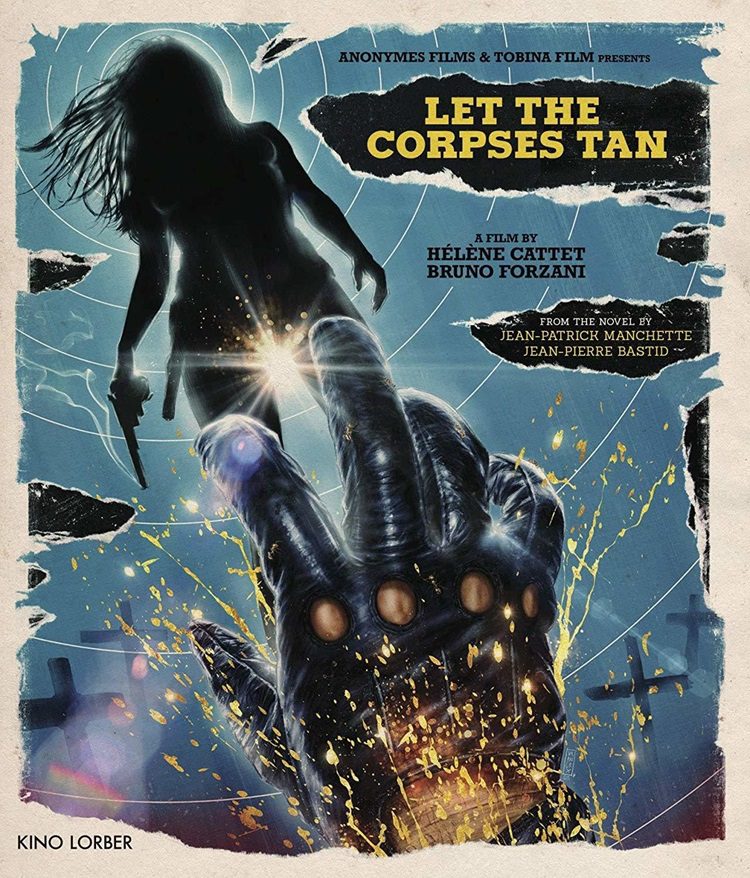
With The Strange Color of Your Body’s Tears, French directors Hélène Cattet and Bruno Forzani created a modern giallo that was a psychedelic audio/visual delight which had virtually no story or plot. With Let the Corpses Tan, they’ve added a touch more story and moved their Italian influences into Spaghetti Western territory but continue the sensory overload. It is a beautiful, strange, exhausting film.
A group of men violently rob a stack of gold bricks from an armored truck, killing everyone aboard. They rush to their hideout but are stopped by a woman standing in the middle of the road. She, along with a young boy whom she nannies and the boy’s mother, are desperate for a ride. Incredibly, the robbers agree. Even more incredible still is that they are all going to the same place: a sprawling, dilapidated Mediterranean compound high atop a scraggly mountain. There, they meet a mysterious woman, Luce (Elina Löwensohn), and her cohort, a novelist who happens to be married to the mother just picked up on the road.
The men plot to kill the women as they are now witnesses but before they can, two cops show up and all hell breaks loose. Bullets are fired, blood is shed, and by the time the sun rises the next morning, nearly everyone will be dead, left to tan in the sun so to speak.
Though its gloriously descriptive title evokes all those classic giallos from the 1970s, Let the Corpses Tan owes more to the films of Sergio Leone, Quentin Tarantino, and Darren Aronofsky than Dario Argento and Lucio Fulci. With its sunbaked scenery, quick-cut editing filled with close-ups, and movement back and forth in time, it is a film filled with style that is both fascinating and tiresome. Its plot is just as simple as I described it. There really isn’t much more that happens, and yet it is still difficult to follow. I intentionally left most of the character names out of my description because the film does very little to distinguish one person from another. There is nothing in the way of background stories or development and there is so much crossing and double crossing that by the midway point I had given up entirely in trying to figure out who was who.
Much like The Strange Color of Your Body’s Tears, the plot is simply a means to a infectiously stylish end. They use extreme close-ups of faces, inanimate objects and lots of ants. They toggle back and forth in quick edits between two faces each new cut zooming in closer and closer. They show single scenes from multiple perspectives, flashing the time on screen as we move forwards and backwards. The violence is fetishized. There are flashbacks to a presumably younger Luce where men blow gold dust onto her nude body, tie her to a crucifix, are urinated on by her, and lick the foamy sweat from her body. What this says about her or anything is beyond me but it certainly is evocative.
If the movie has anything to say beyond copious amounts of style, I don’t know what it is. I haven’t the slightest idea about what it means, but it sure was interesting to watch. The bulk of the film consists of the long battle between the cop and the burly, sweaty men (and amongst themselves as they continue to double cross one another). There is a large section of this sequence that is breathtaking. The bravado direction blends a mix of colors, incredible sound design, and action into a psychedelic cocktail of delight. That this goes on for too long, wearing down the characters and viewer, is maybe besides the point. With a runtime of only 92 minutes, one ought to come out of a film refreshed, but by the time the credits rolled, I felt beaten and warn out. Much like The Strange Color of Your Body’s Tears, this is exciting, experimental visual filmmaking, but I can’t help but hope that next time they find an actual story to tell.
Kino Lorber’s transfer looks quite good, though it does lean towards the dark side. There are scenes set in poorly light room at night where I had difficulty making out who anybody was and what was happening. But the colors and textural detail are quite fine. Audio is quite good; the film uses sound effects to great use, amping up simply things like the way leather sounds rubbing against itself and the surround makes good use of this soundscape. Extras include an engaging audio commentary from film critic Alexander Heller-Nicholas and director John Edmond. It’s full of information on the multitude of references to ’70s Italian films spread throughout the movie.
Let the Corpses Tan is an assault on your senses. It’s a film that might work best at home as you can stop and start it, allowing your brain to reset once its been over stimulated. Kino Lorber’s edition is light on extras but delivers a nice transfer. Recommended for those looking for an adventure.
Buy Let the Corpses Tan